Sentinel Streams
Long Term Biological Monitoring at Reference Streams
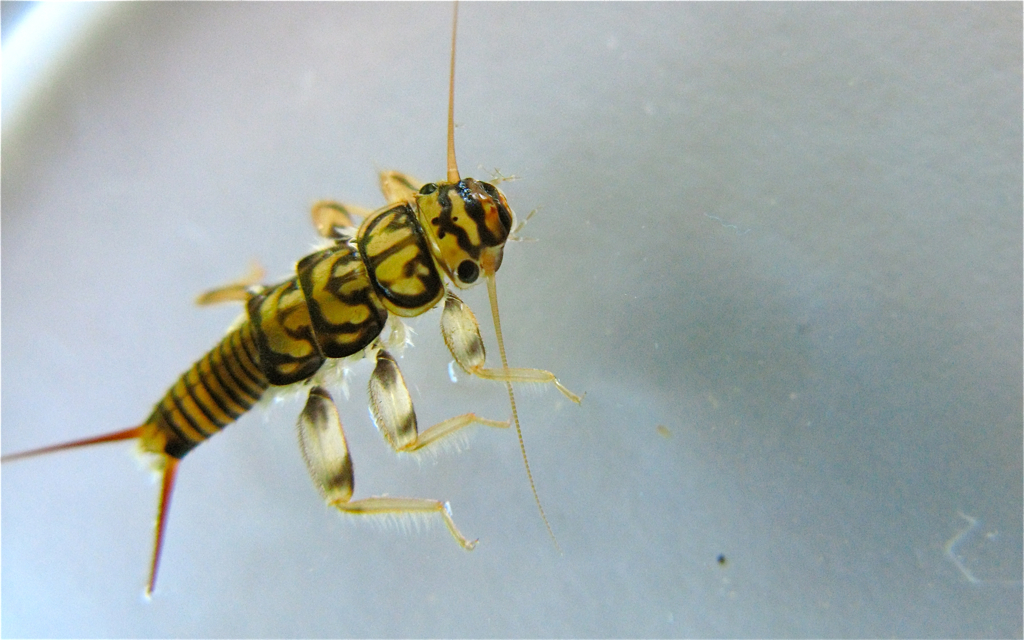
The Vermont Department of Environmental Conservation (DEC) is conducting long term monitoring of twelve “sentinel” streams in Vermont. These reference streams are widely variable in terms of size (4.6-510 km2), elevation (110-1920 ft) and geographical separation. Most are in watersheds that have significant protection against impacts from anthropogenic activity, and all but one has a watershed with greater than 90% combined forest and wetland (based on 2011 land use/land cover data, Table 8). Five of these sentinel streams are included in the US Environmental Protection Agency (EPA) Regional Monitoring Network of high-quality reference streams throughout New York and New England (U.S. EPA, 2016).
By focusing on streams with negligible prospects for development or land use change, DEC hopes to be able to isolate long-term impacts related to climate change. Many of these streams have monitoring data going back to the 1990s, and all are currently being monitored on an annual basis for water chemistry, physical habitat, water temperature, and biological condition. Numerous sites are also being gaged for stream discharge, air temperature, and fish community health. Through this monitoring, one of DEC’s key goals is to gain a better understanding of how climate-induced changes in water quality, temperature and hydrology lead to long-term alterations in biological communities.
One of DEC’s longest running sentinel stream sites is at Ranch Brook in Stowe, Vermont. With a drainage area of 10 km2 and an elevation of 1240 ft, it is one of the smallest and most pristine sentinel streams. Ranch Brook has a record of annual macroinvertebrate community data and a continually operated stream gage since 2000, and has served as a focal point for early analyses on the DEC sentinel network.
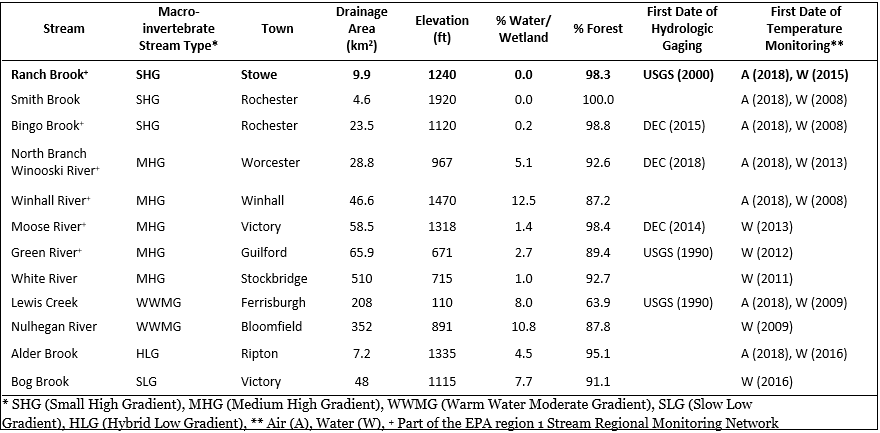
The Data
Vermont DEC collects macroinvertebrate community samples from stream reaches during an annual index period that runs from September 1st through mid-October. Samples are sorted and identified in the laboratory, and DEC biologists use population data, as well as a number of community variables (called metrics) to assess stream health. These metrics cover many aspects of community structure and function, including density, biodiversity, tolerance to pollution and ecological feeding habits.
Metric values are compared to established thresholds determined from historical statewide data. DEC recognizes five stream community types that result from variation in stream size, gradient, and habitat; Small High Gradient (SHG), Medium High Gradient (MHG), Warm Water Moderate Gradient (WWMG), Hybrid Low Gradient (HLG), and Slow Low Gradient (SLG). Metric thresholds can vary by stream type, and outcomes are used to determine an assessment rating for community health, using a tiered scale ranging from Poor to Excellent (VTDEC, 2017). In addition to assessment ratings, this report chooses to focus on three key macroinvertebrate metrics used in assessment determinations. Ephemeroptera, Plecoptera and Trichoptera (EPT) Richness is a measure of the diversity of water quality sensitive taxa (Ephemeroptera, Odonata and Trichoptera (EOT) richness is used in low gradient streams). Total Density is the number of organisms per square meter, and previous analyses at Ranch Brook suggest that this metric reacts strongly and quickly to extreme flow events. Biotic Index (BI) is a metric that demonstrates the macroinvertebrates community’s sensitivity to pollution and/or enrichment, and is correlated with stream thermal regimes (Hilsenhoff, 1987; Hilsenhoff, 1988).
Abiotic data related to stream habitat is collected in conjunction with biology and is used to help explain biological community condition. While water quality and habitat data are collected annually, a primary focus at sentinel streams has been the collection of temperature and hydrological data. Several sentinel sites have been co-located with USGS gaging stations, and DEC has set up stream gages on several others. DEC scientists have also recently begun to use time-lapse cameras to help to visually monitor flow levels, and to track the mobilization of substrate during high flow events. Year-round water temperature data is collected at all twelve sentinel sites, and DEC has initiated an effort to add air temperature monitoring at many locations.
2017 in Summary
Figure 27 shows 2017 results for overall assessment ratings, as well as the results for three key metrics used to assess biological condition. Sentinel sites are grouped by stream type and are compared to average results from a statewide survey of randomly selected streams sampled from 2013 to 2017. Threshold values indicating minimum criteria for “Good” biological condition (Class B(2)) in Vermont streams is also displayed. Results from Ranch Brook include samples taken at both the beginning and end of the 2017 fall index period.
Ranch Brook, the primary case study for sentinel stream monitoring, received assessment ratings of Very Good/Excellent and Excellent for its two community samples in 2017. EPT richness at Ranch Brook (26) was significantly higher than the minimum criteria (16) for small high gradient streams, and moderate density and low BI scores indicate a high-quality stream with exceptional water quality. The fact that Ranch Brook (and other sentinel streams) have metric values relatively similar to statewide averages for randomly selected streams is indicative of the generally high quality of streams throughout Vermont. The high assessment ratings and metric values also show recent consistency in the community, which had shown instability in condition following several extreme flood events in the earlier part of the decade.
Only two of the sentinel sites received an assessment rating lower than Very Good in 2017, and both of these sites (Bingo Brook and Lewis Creek) had ratings limited by slightly elevated BI values. Density, EPT/EOT richness, and BI at all sites easily passed minimum thresholds. In general, all sentinel sites showed robust and healthy macroinvertebrate communities. The plots in Figure 27 also highlight a consistent pattern in Vermont reference streams, whereby larger and warmer streams often have naturally higher invertebrate densities and BI values, and medium sized streams often have the highest diversity.
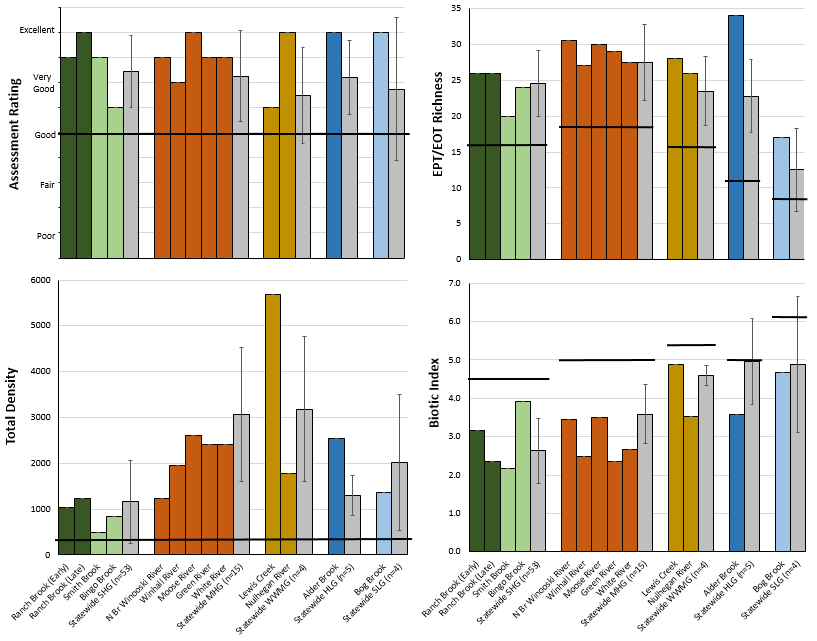
Temperature and discharge profiles from 2017 are given for Ranch Brook, as well as temperature data from representatives for each of the other four stream types (Figure 26). Despite the sites being widely geographically separated throughout Vermont, closely corresponding trends in the temperature data are apparent, including a significant warming period during the middle of DEC’s fall index period. The plot also demonstrates that SHG streams like Ranch Brook are the coldest stream type, with the larger MHG and WWMG streams occupying the other end of the temperature range. Flows at Ranch Brook were relatively stable throughout the summer leading up to, and during, the DEC index period. This likely contributed to the overall health of the biological community compared to previous recent years.
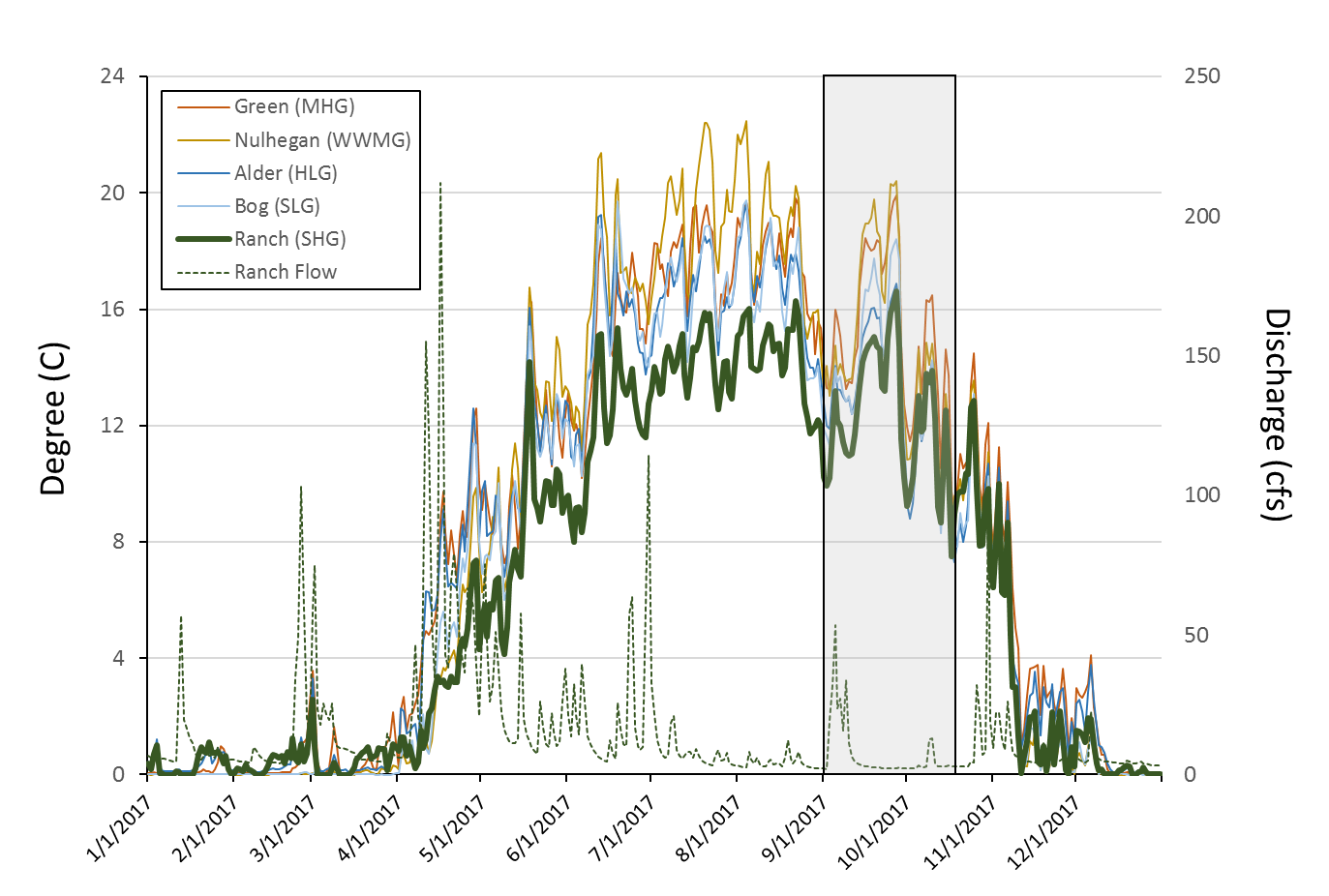
Long Term Trends
While several sentinel sites have been added by DEC since 2012 in an effort to increase the strength of the long-term monitoring program, eight of the sites have biological monitoring data going back to 2003 or earlier (Figure 28). Through this data set, DEC hopes to be able to observe any emergent trends that may be related to climate change or other large-scale factors.
The richness of sensitive EPT taxa appears to have remained relatively steady over time at most sentinel sites. Ranch Brook is a small and relatively low productivity stream. It has slightly lower EPT richness than most other sentinel streams, and all community samples since 2000 have had EPT richness between 20 and 26.
In contrast, macroinvertebrate density has typically shown more variability over time, and has reacted dramatically to high flow events. Tropical Storm Irene caused extreme flooding throughout Vermont in 2011, occurring immediately before the start of DEC’s fall index period. Densities dropped up to an order of magnitude at most small and medium sized sentinel streams, and assessments at these sites generally received failing ratings due to abundances below DEC’s minimum criteria. Densities rebounded in 2012, but some sites had lingering effects in subsequent years as macroinvertebrate communities continued to stabilize.
Ranch Brook experienced a series of high flow events between 2010 and 2013, with the three highest annual peak discharges on record occurring over this four-year period. This resulted in a series of lower than expected assessment ratings due to higher variability in density, BI, and distribution of feeding groups. This trend has appeared to stabilize with less extreme flow events over subsequent years.
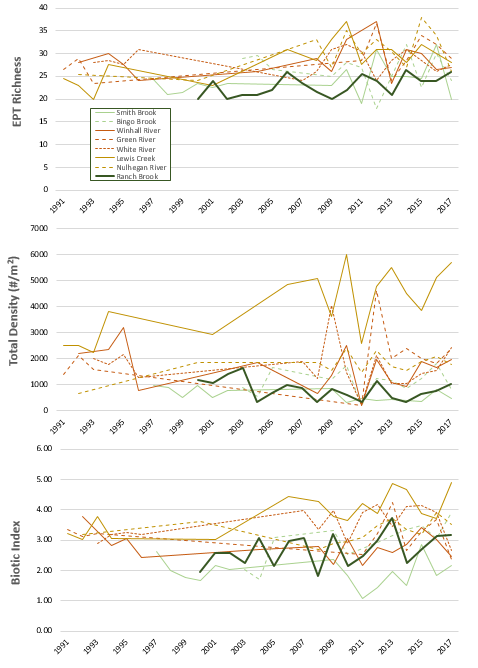
Implications
It will take a much longer period of record to fully understand how water quality, temperature and hydrology are influencing biological communities at sentinel sites. Only Ranch Brook has a continuously paired hydrological and biological record going back longer than 10 years, and most sites only have a water temperature record of 5-6 years. However, it is expected that as the monitoring records increase, patterns may begin to emerge that will help to understand how changes in hydrology (i.e. extreme flow events or drought) and warming temperatures may permanently affect these stream communities. Changes in reference condition due to climatic variables may eventually alter our immediate expectations of a healthy biological community. The monitoring of these sentinel sites, and other reference streams, is essential for DEC’s ability to differentiate impacts caused by climate change versus more localized stressors.
Despite the limitations of the data set, some early patterns are helping our current understanding. The magnitude of flood events like that of Tropical Storm Irene can diminish biological health by dramatically reducing macroinvertebrate densities. The increased frequency of high flow events like those experienced at Ranch Brook may destabilize communities and lead to volatility in metrics and assessments over time. In an ecological context, the instability in community metrics is a direct result of changes in the populations that make up these communities. At Ranch Brook it seems apparent that the magnitude of the annual peak discharge is closely correlated to the relative abundance of the mayfly family Baetidae (Figure 29). Mayflies of this family are known to be early colonizers of disturbed substrates. Other species that depend on colder water may begin to be lost from these communities if average stream temperatures rise. Understanding the population dynamics and life history traits of taxa that vary with climatic variables will be necessary, and DEC hopes to further explore these questions.
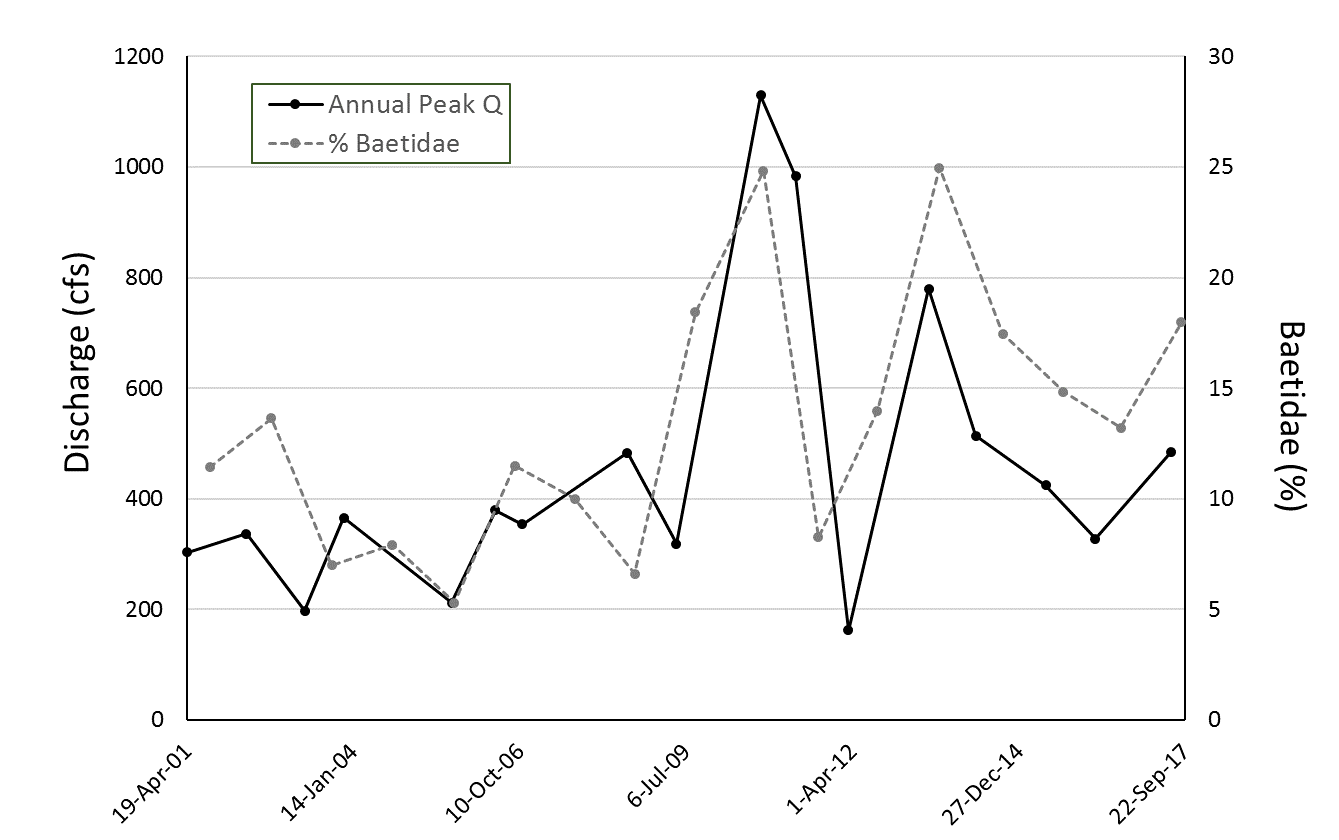
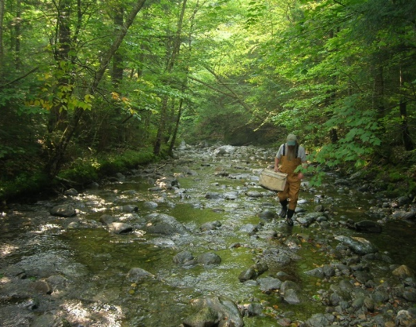
Changes in hydrology and water temperature due to climate change are expected to cause dramatic changes to stream invertebrate communities.
References
- Hilsenhoff, W. L., 1987. An improved biotic index of organic stream pollution. The Great Lakes Entomologist 20: 31-39.
- Hilsenhoff, W. L., 1988. Seasonal correction factors for the biotic index. The Great Lakes Entomologist 21: 9-13.
- USEPA (U.S. Environmental Protection Agency), 2016. Regional Monitoring Networks (RMNs) to Detect Changing Baselines in Freshwater Wadeable Streams. U.S. Environmental Protection Agency, Office of Research and Development, National Center for Environmental Assessment. Washington, DC.
- VT DEC (Vermont Department of Environmental Conservation), 2017. Vermont Water Quality Standards Environmental Protection Rule Chapter 29A. Available online: http://dec.vermont.gov/sites/dec/files/documents/wsmd_water_quality_standards_2016.pdf
Additional Resources
- VT DEC Biomonitoring and Aquatic Studies http://www.watershedmanagement.vt.gov/bass/htm/bs_biomon.htm
FEMC Project Database Link
- Sentinel Stream Monitoring: https://www.uvm.edu/femc/data/archive/project/sentinel-stream-monitoring
